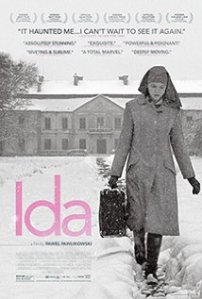A young nun Ida (Agata Trzebuchowska) is a 17 year old novitate. Before reccceivng her holy orders she is asked to leave tne convent and visit her aunt Wanda (Agata Kulesza) who tells Ida she was born Jewish and her parents were murdered during the Holocaust. They journey to find out the details of this war time event. Wanda gets drunk and spends a night in jail (she is a Public Prosecutor who could inflict the death penalty in the early 50s). They confront the perpetrators. Wanda tries to introduce Ida to alcohol, sex, and jazz. Ida meets a jazz player (Dawid Ogrodnik) for whom she has sexual feelings. Does Ida take her vows in the end? What happens to Wanda?
Review
This is set in the early 60s in Communist Poland during the deep freeze of a winter and the Cold War. Ida lived an innocent life in the convent. The scene of the statue in the snow is a classical pose for a painting of the religious life. There is the same lifeless austerity already seen in the asylum in Camille Claudel 1915. The nuns are as statuesque as their convent. Wanda is a hard drinking and smoking cynic who likes a good time and taunts the complacency of Ida’s untested austerity. Wanda is a beacon of hedonism, all compulsive movements and furious cigarette smoking. Ida by contrast is a study in imperturbable stillness, all the more unsettling for its apparent stoicism. She does not feel the need to defend the religious life against Wanda’s cynicism They both visit the farm stolen from their family, where weaselly-faced peasants defend their ill gotten gained cottage in a wintry landscape so raw you can feel it scrape your flesh. They have initially got the wrong man but the murderer is the usual mixture of snivelling justification and conscience-evasion, taking final refuge in self-serving inscrutability. The murderer unearths their remains, transformed by the black and white of the film into a sort of priordial ritual. Given the enormity of what he and the others did to the Jewish victims, Ida and Wanda’s calm refusal to even hint at absolution is dignified. This is a journey into Poland’s terrible past as well as its grey present day (1962). There is a symmetry from the religious imagery from the start of the film (after Ida has renounced the prospect of married life) to the end where Ida walks back to the convent as if on pilgrimage. In the nascent pop culture of Communist Poland the ballroom scenes are quaintly innocent in that anti-puritannical daring, bordering unintentionally on a David Lynch parody of a jazz band in a grey poverty-primitive culture. The black and white compositions of the film are superb, the countryside is practically an Arctic wilderness as if Brueghel-esque grotesque lurked in the woods. Domestic interiors seem more picked out in detail than in a colour film. Faces can be almost superfluous to a scene dominated, for example, by a high wall. Superb.
